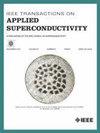Conceptual Design of a Conduction-Cooled Superconducting Quadrupole for ILC Main Linac With Large Temperature Margin
IF 1.7
3区 物理与天体物理
Q3 ENGINEERING, ELECTRICAL & ELECTRONIC
引用次数: 0
Abstract
The International Linear Collider (ILC) Main Linac consists of a series of cryomodules, one third of which are composed by eight 9-cell superconducting RF (SRF) cavities and a superconducting quadrupole (SCQ) package. The electrons and positrons are focused by the quadrupole and steered by the two dipoles included in the SCQ magnet. Large expected dark currents are originated at the SRF cavities and deposit energy at the SCQ. The superconductor in the coils should not surpass its critical temperature before that heat deposition is evacuated.This paper depicts the SCQ electromagnetic design proposed by CIEMAT. Several superconductors were analysed and compared. Nb3Sn wire was selected for the quadrupole coils relying on the large temperature margin for the absorption in the superconducting coils of the heat deposition from the dark currents. The magnet cross-section has been carefully optimized for the HE type of the SCQ magnet to achieve a good field quality and superconductor efficiency in spite of the expected iron saturation. The dipole coils were protected from the heat deposition, enabling the election of Nb-Ti wire. The longitudinal space has been defined with an electromagnetic 3D model.大温度裕度ILC主直线加速器电导冷却超导四极杆的概念设计
国际直线对撞机(ILC)主直线加速器由一系列低温模块组成,其中三分之一由8个9单元超导射频(SRF)腔和一个超导四极子(SCQ)封装组成。电子和正电子由四极子聚焦,并由SCQ磁体中的两个偶极子引导。预期的大暗电流起源于SRF腔,并在SCQ处沉积能量。在热沉积被排出之前,线圈中的超导体不应超过其临界温度。本文介绍了CIEMAT提出的SCQ电磁设计方案。对几种超导体进行了分析和比较。四极线圈选用了Nb3Sn线,利用其较大的温度裕度在超导线圈中吸收暗电流产生的热沉积。对于HE型SCQ磁体,磁体的横截面进行了仔细的优化,以在预期的铁饱和情况下获得良好的磁场质量和超导体效率。偶极子线圈不受热沉积的影响,有利于Nb-Ti线的选择。纵向空间用电磁三维模型定义。
本文章由计算机程序翻译,如有差异,请以英文原文为准。
求助全文
约1分钟内获得全文
求助全文
来源期刊

IEEE Transactions on Applied Superconductivity
工程技术-工程:电子与电气
CiteScore
3.50
自引率
33.30%
发文量
650
审稿时长
2.3 months
期刊介绍:
IEEE Transactions on Applied Superconductivity (TAS) contains articles on the applications of superconductivity and other relevant technology. Electronic applications include analog and digital circuits employing thin films and active devices such as Josephson junctions. Large scale applications include magnets for power applications such as motors and generators, for magnetic resonance, for accelerators, and cable applications such as power transmission.
 求助内容:
求助内容: 应助结果提醒方式:
应助结果提醒方式:


